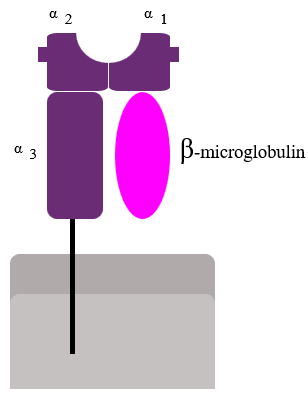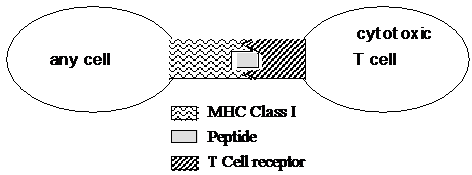User:Jeremiah C Hagler/Sandbox 2
From Proteopedia
(Difference between revisions)
| Line 8: | Line 8: | ||
You will also encounter MHC molecules if you choose to have yourself tissue typed as a bone marrow or organ donor. There are many different types of MHC molecules - different alleles for the gene; in your body you only use 6 different types and this helps to establish your unique molecular identity - the combination of your six types will certainly be different from your lab mate, but perhaps the same as a family member - remember the joy of genetics. | You will also encounter MHC molecules if you choose to have yourself tissue typed as a bone marrow or organ donor. There are many different types of MHC molecules - different alleles for the gene; in your body you only use 6 different types and this helps to establish your unique molecular identity - the combination of your six types will certainly be different from your lab mate, but perhaps the same as a family member - remember the joy of genetics. | ||
From a structural point of view, MHC molecules are also cool because you can clearly see alpha helices, beta-pleated sheets, ionic bonds, and quaternary structure. An apt description of the MHC-peptide complex is that it looks like a hot dog (peptide) in a bun (MHC). One other interesting note: the MHC complexes are closely related to immunoglobulins, both being made up of the same basic protein domain motifs (along with the T-cell receptor and several other important immune molecules). These genes all belong to a “superfamily” of related genes, the Ig superfamily. | From a structural point of view, MHC molecules are also cool because you can clearly see alpha helices, beta-pleated sheets, ionic bonds, and quaternary structure. An apt description of the MHC-peptide complex is that it looks like a hot dog (peptide) in a bun (MHC). One other interesting note: the MHC complexes are closely related to immunoglobulins, both being made up of the same basic protein domain motifs (along with the T-cell receptor and several other important immune molecules). These genes all belong to a “superfamily” of related genes, the Ig superfamily. | ||
| - | + | [[Image:T-Cell MHC I binding.png]] | |
== Disease == | == Disease == | ||
Revision as of 00:26, 13 September 2015
Protein 1: MHC Class I
| |||||||||||


